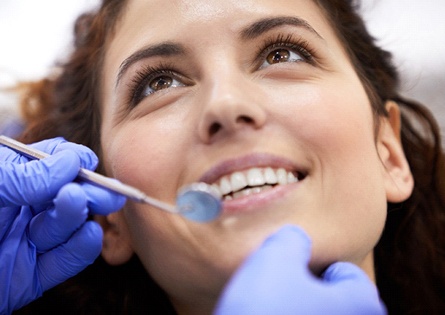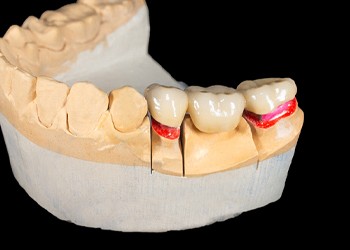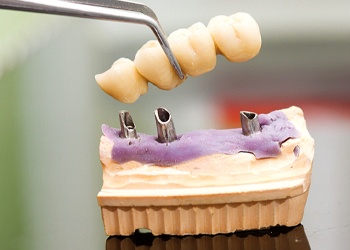Dental Bridges North Dallas
Seamlessly Replace One or More Missing Teeth
According to the American Academy of Prosthodontists, an estimated 140 million people are missing at least one tooth. If you find yourself with one or several consecutive gaps in your smile, know that our team at Coco Dental of North Dallas offers high-quality tooth replacement solutions known as dental bridges in North Dallas that can help you. Whether you’re having difficulty chewing your food or speaking, our restorations can help you not only regain the complete function of your full set of teeth, but they’re also aesthetically beautiful, seamlessly integrating with your natural existing teeth. To learn more about dental bridges and whether you’d be a good candidate for this procedure, we invite you to schedule a consultation with your dentist in North Dallas today.
Why Choose Coco Dental of North Dallas for Dental Bridges?
- We Accept Dental Insurance
- High-Quality, Durable Dental Restorations
- Natural-Looking Replacement Teeth
What Is a Dental Bridge?

A dental bridge is a prosthetic that’s custom-crafted from natural-looking dental materials, like ceramic and porcelain. These are color-matched to your tooth enamel, so once they’re placed, onlookers won’t be able to tell that you have a restoration. The prosthetic itself is comprised of two dental crowns located on either side of free-standing replacement teeth, called pontics. The crowns are anchored to your existing teeth on either side of the gap, allowing the pontics to fill the space in your smile.
Types of Dental Bridges

During your initial consultation with Dr. Patel, our team will examine your mouth, learn about any specific smile goals you’d like to meet, and ask you about your medical and oral health history. Based on our discussion, we’ll walk you through each of your treatment options.
Traditional Bridge

To replace one or more missing teeth in North Dallas that are next to each other, we can utilize a traditional dental bridge that’s anchored to your mouth with crowns. This will require the alteration of your natural, healthy teeth to replace the missing ones.
Implant Bridge

As an alternative, we also offer implant bridges, which are secured to your mouth using two dental implants instead of dental crowns. The implants are placed on either side of the gap in the smile, and after they’ve fused with the jawbone, we’ll be able to attach the dental bridge to the implants to replace two or more missing teeth. This treatment requires no alteration of your existing teeth.
The Benefits of Getting a Dental Bridge

When you replace consecutive missing teeth, you’re able to enjoy a wide array of benefits, including:
- Maintain the alignment of your existing teeth.
- Maintain and improve your oral health by making brushing and flossing easier.
- Preserve your jawbone with an implant denture.
- Long-lasting restoration that can last up to 15 years (traditional) or over 35 years (implant-retained).
- Natural-looking restoration that blends in with existing teeth.
- Easy to care for.
If you’d like to learn more about dental bridges, don’t hesitate to call our office today!
Dental Bridges FAQs
Can You Take a Dental Bridge Out?
No, and we don’t recommend making the attempt! Your dental bridge is designed, for all intents and purposes, to be a long-lasting fixture in your mouth. This provides patients a stable, reliable restoration that’s easy to maintain and feels more like natural teeth. If you believe your dental bridge might need repaired or replaced, it’s better to contact our office so we can remove it safely with our professional tools.
What Are Dental Bridges Made Of?
We craft our dental bridges from tooth-colored ceramic and porcelain materials. Though they’re very similar, these two substances are technically different.
Porcelain is made with a denser clay and is fired in the kiln for a longer period than ceramic, making it generally more durable. While both our porcelain and ceramic bridges can be made to match the color of your remaining teeth, some patients prefer the aesthetics of our ceramic bridges. When you schedule your consultation, we can go more in-depth about the materials we use and which one might be better suited for your smile.
Is Getting a Dental Bridge Painful?
Before preparing your teeth to receive this restoration, we’ll numb the area with an effective anesthetic. As a result, most patients experience minimal discomfort during their dental bridge treatment. After you return home and the anesthetic wears off, however, you’re likely to feel some tender teeth. Over the counter pain medication is usually enough to alleviate these aches, but if your pain gets worse or lasts for several days, be sure to let us know as soon as possible.
How Long Should a Dental Bridge Last?
It depends on what your bridge is made out of and how well you take care of it, but generally speaking, you can expect your restoration to last for up to 15 years.
Proper maintenance is not only important for preserving the look of your dental bridge, but also saving you money in the long run! To help your bridge stand the test of time, we recommend:
- Brushing your teeth twice daily, taking special care around your restoration
- Flossing once per day with dental thread or an oral irrigator
- Avoiding bad habits such as nail biting, using your teeth as tools, snacking on ice, smoking, etc.
If you’d like more tips on maintaining your dental bridge, you know who to call! We’d be happy to give you personalized recommendations.
How Many Teeth Can a Dental Bridge Replace?
A dental bridge can replace up to four missing adjacent teeth, assuming it’s made well. The device is thus a good “middle-ground” option between dental implants and traditional dentures.
All that said, most dentists only use dental bridges to replace one or two teeth. The devices become increasingly unstable as they reach out, putting treatment results at risk. (This danger is especially high when the bridge’s abutments aren’t strong.) Therefore, most practices won’t use them to replace three or four teeth at once.
The only exceptions to this tooth limit are implant bridges. Since these kinds use dental implants, they’re unlikely to fail from replacing multiple teeth.
Can a Dental Bridge Be Whitened?
Sadly enough, dental bridges can’t be whitened like natural teeth can. Their design keeps them from changing color due to cosmetic work.
Note that teeth whitening relies on a strong bleaching gel. This substance enters tiny pores in your enamel to remove stains, ensuring your whole smile looks brighter. Because dental bridges don’t have pores, the whitening process doesn’t affect their coloring.
Of course, there are workarounds for this issue. One option is to whiten your teeth before getting a dental bridge, as this makes your entire smile the same color. You can also replace an old dental bridge with a new one after your teeth get brighter.
Do Dental Bridges Feel Natural?
All in all, a dental bridge feels pretty natural within days of its placement. It shouldn’t cause any odd or unwanted sensations in the long run.
Don’t forget that dental bridges consist of durable materials. Most use high-quality ceramic and porcelain, which can withstand chewing forces as easily as tooth enamel. Eating with these devices won’t (or at least shouldn’t) cause feelings of looseness, brittleness, etc.
More crucially, every dental bridge is customized for its patient’s mouth. Your own would be designed and modeled after impressions of your smile, so it’d fit snugly and comfortably. It won’t feel awkward or even noticeable after extended use.
Can Dental Bridges Get Cavities?
Dental bridges ultimately can’t get cavities, as they’re artificial and don’t decay from bacterial acid. However, the abutment teeth securing them still could.
A traditional bridge uses nearby natural teeth – “abutments” – to stay in place. If these pearly whites get exposed to bacteria and debris, they’ll slowly decay over time. They could then develop cavities that make your bridge unstable, causing your treatment to fail.
Given these points, dental bridge users must always protect their smiles. The best ways to do so include twice-daily brushing, once-daily flossing, and frequent dental checkups. Through these methods, you’ll keep bacteria from decaying your abutments.
